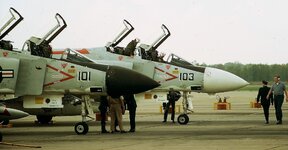As a Naval Aviator and F-4B/J pilot, I'm showing my vulnerable side and admitting that I don't know everything.
Talking with a scale modeler and he was curious about the mix of white and black nose cones on our birds.
Photo is from 1971 @ VF-31. Can anyone elaborate?
As an AT(N) (Aviation Electronics Tech - Navigation) when enlisted, I wondered about that, and was told by our radar guys (I specialized in the Nav, comm and ASW sides) that antennae had to have special, non metallic coating, and many paints use lead, cadmium, titanium, iron, chromium, copper oxides etc. for pigments. These were applied to our UHF and TACAN blade antenna and radomes, not to be painted to match the airframe color. These metals could degrade the radar performance and also, heat up with the high powered transmissions, to the detriment of the composite structure.
Supposedly, One of Navy suppliers came up with a white rubberized coating that held up better with abrasion, especially in salt air. There was a belief among many of our F-4 RIOs that they got better returns on the pulse doppler AWG-10 from the black noses.
Note that you'll rarely if ever see an Air Force bird with a white nose cone, despite McNamara's vaunted joint supply system.
Sure, the Blues had colored noses, but they often had 'lead nose' radars ... if not always.
In later days, a lot of outfits had grey radomes to match the rest of the bird, and I assume it was another specialized paint.
I hope some RIOs chime in.
Talking with a scale modeler and he was curious about the mix of white and black nose cones on our birds.
Photo is from 1971 @ VF-31. Can anyone elaborate?
As an AT(N) (Aviation Electronics Tech - Navigation) when enlisted, I wondered about that, and was told by our radar guys (I specialized in the Nav, comm and ASW sides) that antennae had to have special, non metallic coating, and many paints use lead, cadmium, titanium, iron, chromium, copper oxides etc. for pigments. These were applied to our UHF and TACAN blade antenna and radomes, not to be painted to match the airframe color. These metals could degrade the radar performance and also, heat up with the high powered transmissions, to the detriment of the composite structure.
Supposedly, One of Navy suppliers came up with a white rubberized coating that held up better with abrasion, especially in salt air. There was a belief among many of our F-4 RIOs that they got better returns on the pulse doppler AWG-10 from the black noses.
Note that you'll rarely if ever see an Air Force bird with a white nose cone, despite McNamara's vaunted joint supply system.
Sure, the Blues had colored noses, but they often had 'lead nose' radars ... if not always.
In later days, a lot of outfits had grey radomes to match the rest of the bird, and I assume it was another specialized paint.
I hope some RIOs chime in.

